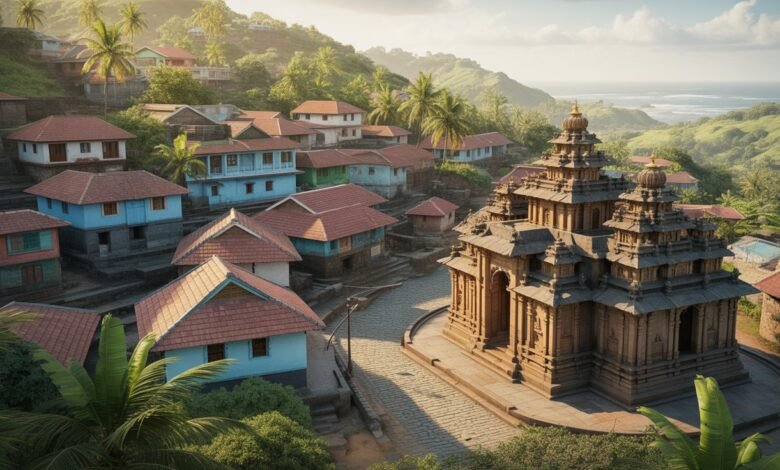Polali: Discover the Divine Heritage of Karnataka’s Rajarajeshwari Temple

Nestled in the lush greenery of Karnataka’s Dakshina Kannada district lies a peaceful village called Polali. This serene destination is best known for the Polali Rajarajeshwari Temple, a centuries-old shrine that continues to attract devotees, history lovers, and curious travelers from across the world. The temple, surrounded by coconut trees and the calm waters of the Phalguni River, feels like a place where time itself slows down.
What makes Polali so special isn’t just its beauty but the deep sense of spirituality that lingers in the air. Every corner of this small village seems to tell a story — of faith, culture, and community. Whether you are a pilgrim seeking blessings or a traveler exploring heritage sites, Polali offers an experience that touches both the heart and soul.
The History and Legends of Polali
The origins of Polali trace back to ancient times. The name Polali is believed to have evolved from the old Tulu term “Pural” or “Porala”, meaning a sacred or divine place. Locals say that Polali’s history dates back several centuries, possibly to the early medieval period when kings and dynasties ruled this region.
One of the most fascinating legends associated with Polali speaks of King Suratha, a ruler who was deeply devoted to the goddess Rajarajeshwari. According to the story, he installed the clay idol of the goddess and offered his own crown at her feet, symbolizing humility and devotion. This act of surrender became a cornerstone of the temple’s mythology, representing the eternal bond between divine power and human faith.
Over the centuries, many kingdoms — including the Alupas, Kadambas, and Vijayanagara rulers — contributed to the temple’s growth. Inscriptions found in and around Polali mention endowments, donations, and temple renovations, proving its long-standing historical importance.
What makes Polali unique is that, despite its age, it has never lost its spiritual charm. The same rituals performed hundreds of years ago are still observed with devotion today, preserving a heritage that connects generations.
Polali Rajarajeshwari Temple: Architecture and Deities
The Polali Rajarajeshwari Temple is a masterpiece of traditional South Indian architecture. The temple’s structure, built using wood, laterite, and copper, reflects the craftsmanship of artisans who understood the balance between beauty and spirituality. The copper sheets that cover the roof gleam in the sunlight, giving the temple a royal and divine aura.
The most striking feature of the temple is its main deity, Goddess Rajarajeshwari — a powerful manifestation of Goddess Shakti. Unlike most idols carved from stone or metal, this idol is made from clay mixed with medicinal herbs, an ancient technique that gives it a unique texture and sacred value. The belief is that this combination purifies the surroundings and radiates positive energy.
Inside the temple, one can find smaller shrines dedicated to other deities like Lord Subramanya, Goddess Saraswati, and Lord Ganesha. The interior walls and pillars are beautifully carved with mythological motifs and intricate patterns, narrating tales from Hindu scriptures. The temple’s ambiance is serene, filled with the soft scent of sandalwood, flowers, and incense sticks — creating an atmosphere of pure devotion.
A special ritual known as Lepashta Gandha is performed every twelve years. During this ritual, the idol is coated with a sacred paste made from herbal and natural ingredients, symbolizing rejuvenation and divine renewal. Such traditions remind us that spirituality in Polali is not just a matter of worship, but a living, breathing practice of preservation and respect.
Festivals and Rituals in Polali
One cannot talk about Polali without mentioning its vibrant festivals. Among these, the most famous is the Polali Chendu Festival, a unique tradition that blends devotion, sport, and community spirit. The word “Chendu” means “ball” in Tulu, and this festival features a symbolic football match that represents the eternal battle between good and evil.
The Chendu festival lasts for five days, and people from neighboring towns and villages gather to participate. The energy in the air is contagious — drums beat, conch shells blow, and the entire village comes alive with chants and cheers. For locals, this isn’t just a game; it’s a sacred ritual that brings people together, fostering unity and joy.
Apart from Chendu, the annual temple festival is another major celebration that spans several weeks, usually between March and April. The festivities include processions, traditional dances, and elaborate rituals. The goddess is placed on a beautifully decorated chariot and taken around the village streets, allowing everyone to offer prayers.
During these days, Polali becomes a kaleidoscope of colors — lamps lighting up every corner, devotees in traditional attire, and melodious hymns echoing through the night. The festival is not only a display of faith but also a reminder of the community’s shared identity and heritage.
Visiting Polali Temple: Travel and Tips
For anyone planning to visit Polali, the journey itself feels sacred. The village is located about 20 kilometers from Mangalore, making it easily accessible by road. The route passes through lush green fields, coconut plantations, and small streams — offering a glimpse of Karnataka’s serene countryside.
The best time to visit Polali is during the annual festival season, when the temple and its surroundings are decorated with flowers, lights, and banners. However, even on regular days, the temple maintains a peaceful charm, ideal for meditation and quiet reflection.
Temple Timings
-
Morning Puja: 6:30 AM
-
Midday Puja: 12:30 PM
-
Evening Puja: 7:00 PM
Visitors are advised to dress modestly and maintain silence inside the temple premises. Photography is restricted in certain areas to protect the sanctity of the space. The temple also offers free meals, known as Anna Prasadam, prepared and served with love by the temple volunteers.
If you’re visiting from outside Karnataka, Mangalore city provides plenty of lodging options. From there, local taxis or buses can take you directly to Polali. Spending a day here allows you to experience both the spiritual and cultural sides of Karnataka in their purest form.
Cultural and Social Importance
Beyond religion, the Polali Temple serves as the cultural backbone of the region. It has influenced local art, music, dance, and even language. The temple’s annual events give a platform to traditional performers, musicians, and artisans to showcase their talent, preserving age-old traditions that might otherwise fade away.
For locals, Polali isn’t just a temple — it’s a way of life. Families have served the temple for generations, passing down roles and responsibilities with pride. The temple also contributes to social welfare through charitable activities such as feeding the poor, supporting education, and helping local farmers.
In today’s fast-paced world, Polali stands as a reminder of the importance of community and faith. It shows how spirituality can unite people beyond social and economic divides, creating a sense of shared belonging.
Conservation and Heritage Preservation
Maintaining a temple as old as Polali is no small task. Over the years, weathering and modernization have posed challenges to its preservation. Yet, local committees and devotees have worked tirelessly to ensure that the temple’s beauty and sanctity remain untouched.
Restoration projects have focused on repairing the temple roof, reinforcing the wooden structures, and preserving old inscriptions. Special care is given to the clay idol, as it requires traditional maintenance methods using herbal substances. These efforts are not just about conserving a structure but about safeguarding the spirit of devotion that it represents.
What’s inspiring is how the local community participates in this process. People volunteer, donate funds, and contribute their time to keep the temple thriving. Such collective responsibility makes Polali more than a heritage site — it’s a living legacy sustained by faith and love.
Personal Impressions and Experience
Visiting Polali feels like stepping into another world. The first thing that strikes you is the tranquility — the gentle rustle of trees, the fragrance of incense, and the distant sound of temple bells. The Phalguni River flowing nearby adds to the temple’s calm and sacred atmosphere.
Standing before the clay idol of Goddess Rajarajeshwari, one can feel a deep sense of peace. The eyes of the goddess, delicately painted, seem to radiate compassion and strength. During my visit, I noticed devotees bowing their heads in silence, some with tears of devotion, others smiling softly as they offered flowers.
During the Chendu festival, the scene transforms completely. The once-quiet grounds burst into life, with young men playing the traditional ball game while the crowd cheers passionately. It’s a beautiful blend of faith and festivity — a reminder that devotion doesn’t always have to be solemn; it can also be joyful and vibrant.
Every traveler leaves Polali with a story, a memory, or simply a feeling that stays long after they return home. It’s a place that touches you deeply, even if you can’t fully explain why.
Conclusion
Polali is more than a destination — it’s an experience of timeless devotion, cultural pride, and community spirit. The Polali Rajarajeshwari Temple stands as a symbol of resilience and continuity, keeping alive traditions that have thrived for centuries.
Whether you’re a pilgrim seeking blessings or a traveler searching for heritage, Polali offers something rare — a sense of connection that transcends religion and geography. Its festivals, architecture, and warm-hearted people all come together to form a living story of faith and unity.
In a world that’s constantly changing, Polali reminds us of what truly matters — the power of faith, the beauty of tradition, and the strength of community.
Frequently Asked Questions (FAQ)
Q1: Where is Polali located?
Polali is located in Bantwal taluk, Dakshina Kannada district, in the state of Karnataka, India.
Q2: Who is the main deity of Polali Temple?
The main deity is Goddess Rajarajeshwari, a powerful form of Goddess Shakti.
Q3: What is special about the idol in Polali Temple?
The idol is made of clay mixed with medicinal herbs, which is rare and believed to have spiritual and healing properties.
Q4: What is the Polali Chendu festival?
It’s a unique five-day ball game festival symbolizing the victory of good over evil, celebrated with great enthusiasm every year.
Q5: When is the best time to visit Polali?
The best time to visit is between March and April during the annual temple festival, though it remains open and peaceful throughout the year.
Title:
Polali: Discover the Divine Heritage of Karnataka’s Rajarajeshwari Temple
Meta Description:
Explore Polali, a sacred village in Karnataka known for the ancient Rajarajeshwari Temple. Learn about its history, architecture, festivals, and spiritual significance in this detailed cultural guide.

